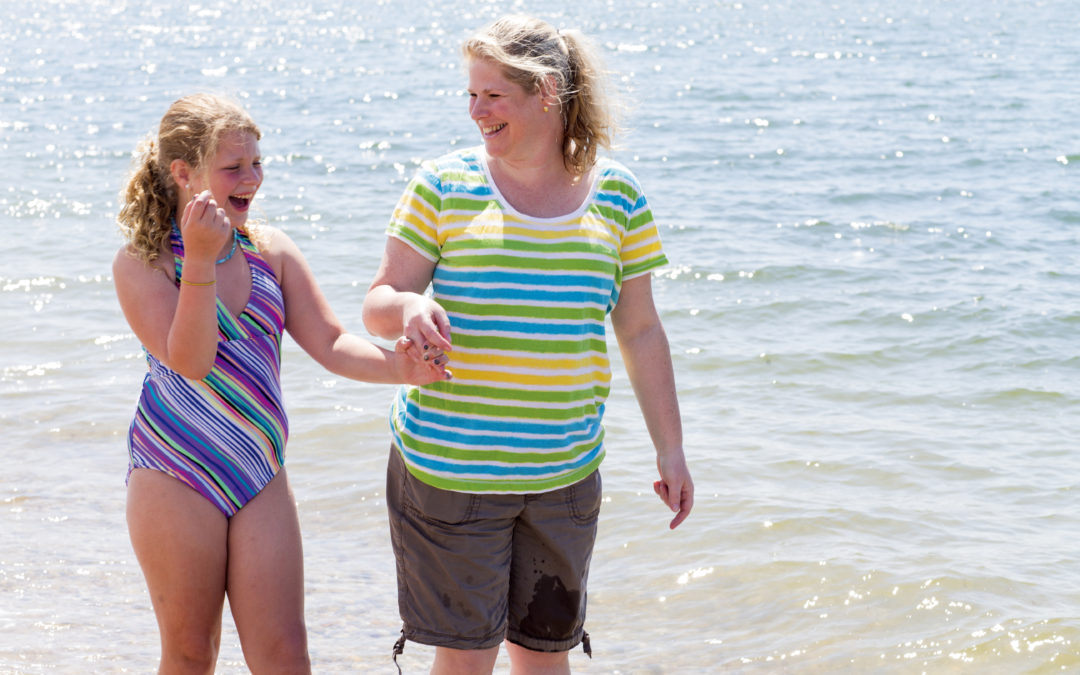Growing up and being a girl in today’s world can be hard. For many girls entering middle and high school, what was once easy and natural now is more confusing. School yards, cafeterias, sports fields, and even classrooms become more difficult to navigate as friendships and relationships change with time. Girls who once cheerfully shared their days, with the experiences and challenges they faced within them, become more reserved as they get older, leaving the caring adults in their lives unaware of the social landscapes that their girls are facing.
Pin this post for later!
As Girl Scout volunteers, we may be asking ourselves, how can we support the growing girls in our lives? The threshold towards adulthood inches closer for them every day, and the learning curve for girls entering middle and high school is steep. Helping our girls find the strength and tools to be resilient, confident, and kind to themselves and others seems like a daunting, but important, task. Here are some tips on how to be there for your girls, even (and especially when) they don’t think they need it.
Teaching girls resiliency
In movies and books, there is almost always a villain and a hero. The villain is always bad, cruel, and mean, while the hero is kind and good. This trope is seen most perfectly in teen fiction, film, and television. There is always a “mean” girl, with the stylish outfits and the best lines.
The reality of life though, is not so simple. For girls leaving the relative comfort of elementary school, middle and high school are full of young people who are neither 100% evil nor 100% good. Everyone is capable of change and everyone is capable of kindness, no matter their experiences.
In a recent New York Times article, “Teaching Teenagers to Cope with Social Stress,“ Dr. David Yeager of the University of Texas at Austin conducted a study to help teens learn techniques to manage and thrive socially as they get older. The study showed that teens who learned one simple message, through reading and writing exercises, showed higher confidence in coping and slightly higher grades at the end of the school year when compared with the control group. The message? People can change.
This study, which is currently being expanded to include more high schools, showed that, “if teenagers can hold onto a long view, they can soldier through immediate mortifications at the cafeteria lunch table. The takeaway: You are not doomed to be excluded forever. Neither your personality nor that of your tormentor’s is frozen.”
Although in the study adults played very small roles, it is clear that even the smallest amount of supportive messaging can be exactly what a developing teen needs. Telling our girls that things do get better, people can change (including themselves), and that everybody has the capacity for kindness can likely hold an impact far stronger than we might think.
Help girls foster real friendships
The phrase “quality over quantity” is used pretty often in our lives, usually given as advice about keeping or giving away material belongings. But as girls get older and the social landscape changes, this phrase can also be applied to friendships. Often, the quantity of people seated at the lunch table, “likes” on a social media post, and even birthday party attendees are viewed as social currency: the higher the better.
As adults and mentors, we can encourage the girls in our lives to foster and nurture real, quality friendships, so they surround themselves with peers who support and care for them. We can model this idea in our own lives, sharing stories of times when friends were there for us when we needed them most, and how strong the impact of a good friend is to our lives and who we grew up to be.
Educator and author Annie Fox, who partners with Girl Scouts of Northern California for events on friendship and communication, stresses the importance of helping girls determine which people in their lives are true friends, and which aren’t. In her book, “The Teen Survival Guide to Dating & Relating” (page 132) Annie lays out that real friends:
- Respect each other’s values
- Talk openly about what’s on their minds
- Keep agreements they make
- Support each other
- Share expectations about what friendship means
While not every friend, especially those in middle and high school, is able to fulfill every one of these qualities all the time, it’s important to help girls understand what real friendship looks like, beyond the number of “likes” on a photo or seats at the lunch table.
Find a balance between independence and guidance
When girls are younger, there’s almost always an adult ready with a bandage or a hug for the little inconveniences like falling while learning how to ride a bike, or tripping while running down the driveway. But as girls get older, they start to experience social challenges and issues that can’t be fixed so easily. Adults are still there wanting to solve things, but it is important to find a balance between giving girls the space and independence they need to solve their own problems, while also setting ourselves up as systems of support and guidance should they need it.
Brene Brown, a research professor at the University of Houston Graduate College of Social Work, encourages parents and adults to practice “a culture of empathy.” When applied to older girls, practicing empathy by simply being there for them during tough times can be challenging, but meaningful.
As adults we want to help our girls fix their friendship and communication problems, but Brown emphasizes that empathy – which seeks to build connection without necessarily attempting to fix the issue – can help someone who is struggling so much more. In Brown’s TED Education speech, she talks about how important it is to practice empathy, despite our instincts to offer advice or try to resolve situations. She says, “Rarely can a response make something better. What makes something better is connection.”
Middle school and high school are times of immense change – the kind that helps shape us into the people we grow to be. For the girls in our lives, these years are full of friendships that grow deeper and stronger than any they had experienced before, and for many of them the peers they grow up with are people who will remain in their lives forever. As adults, we can help equip our girls with the confidence, kindness, and strength to have friendships, troops, and classrooms where compassion and communication is valued. Not everything can be fixed with a bandage, but we can still be there for them when they need it.
What to do next:
- Share this post with a friend and other adults with older girls.
- Share times that a friend has made an impact in your life in the comments.
- Girl Scouting is proven to prepare girls for a lifetime of leadership. Learn more from the Girl Scout Research Institute and their findings from The Girl Scout Impact Study.
- Want more in person advice? Attend Annie Fox and GSNorCal’s events, just for Cadettes and adults, called “Can You Relate?” With dates in the spring, girls can get tools and share ideas for maintaining and finding healthy and supportive friendships.
 Gabi Reyes-Acosta—Gabi is a Program Manager for Girl Scouts of Northern California, where she works to create experiences and programs for girls to enrich their Girl Scouting experience. A graduate of Saint Mary’s College of California, Gabi has been a member of the Girl Scouts family since she was a Daisy (Girl Scouts of Central California South!). In college, Gabi found her passion for helping girls develop their leadership skills while having fun as she worked several summers as a camp staff member at Camp Bothin, and again during her years serving in AmeriCorps in Oakland. A lover of all things outdoors (there’s nothing better than songs and stories around the campfire), Gabi can usually be found in any Bay Area park, wilderness, or forest with her dog close behind.
Gabi Reyes-Acosta—Gabi is a Program Manager for Girl Scouts of Northern California, where she works to create experiences and programs for girls to enrich their Girl Scouting experience. A graduate of Saint Mary’s College of California, Gabi has been a member of the Girl Scouts family since she was a Daisy (Girl Scouts of Central California South!). In college, Gabi found her passion for helping girls develop their leadership skills while having fun as she worked several summers as a camp staff member at Camp Bothin, and again during her years serving in AmeriCorps in Oakland. A lover of all things outdoors (there’s nothing better than songs and stories around the campfire), Gabi can usually be found in any Bay Area park, wilderness, or forest with her dog close behind.



A great read! Very informative and was interesting to reflect on this article with regards to my own time as a girl scout and looking back on those experiences as the adult I am now.